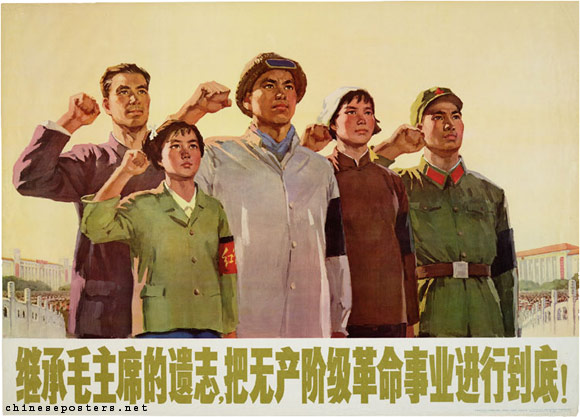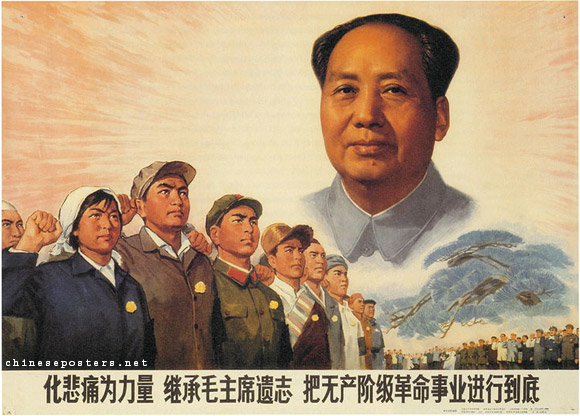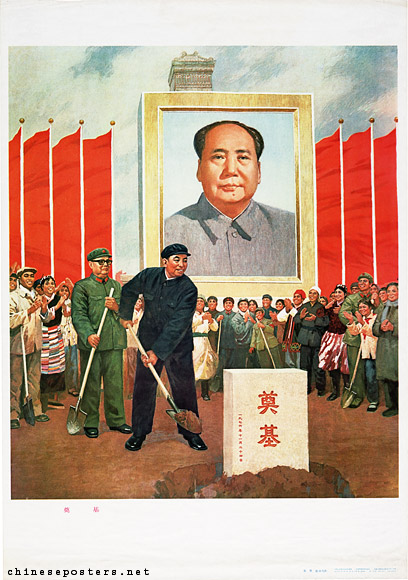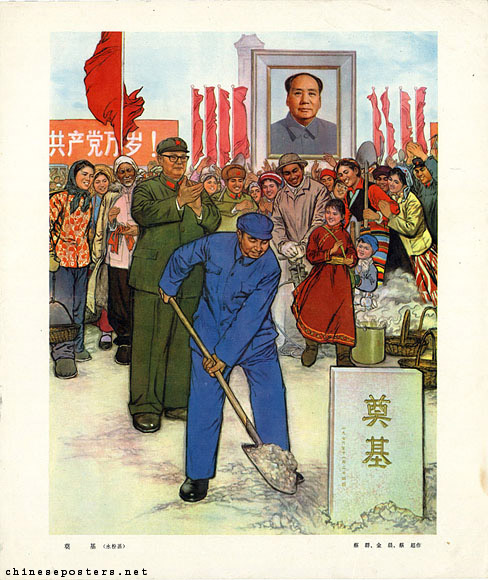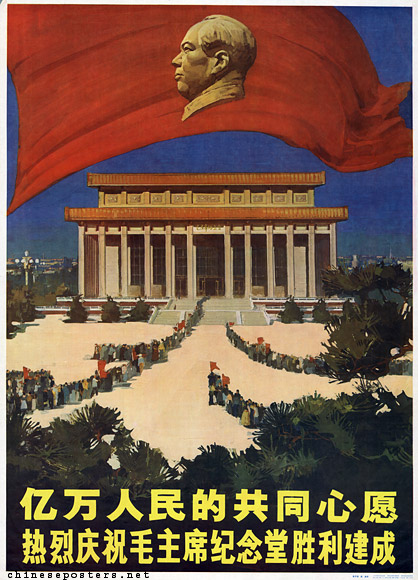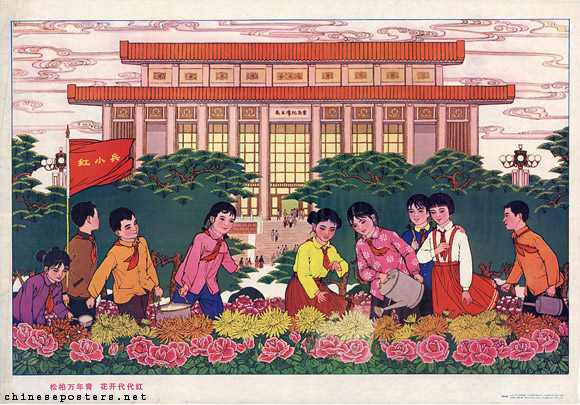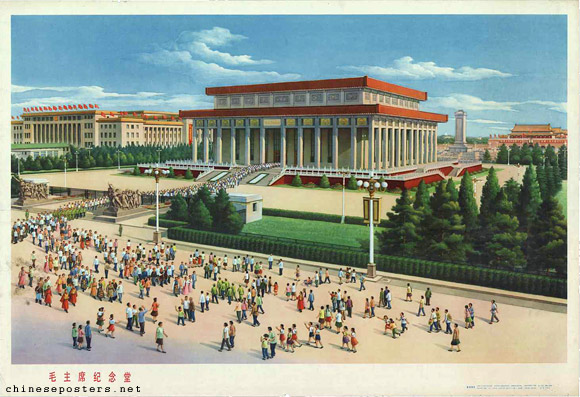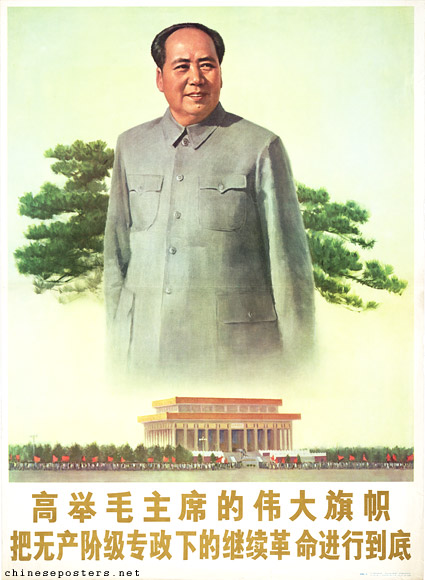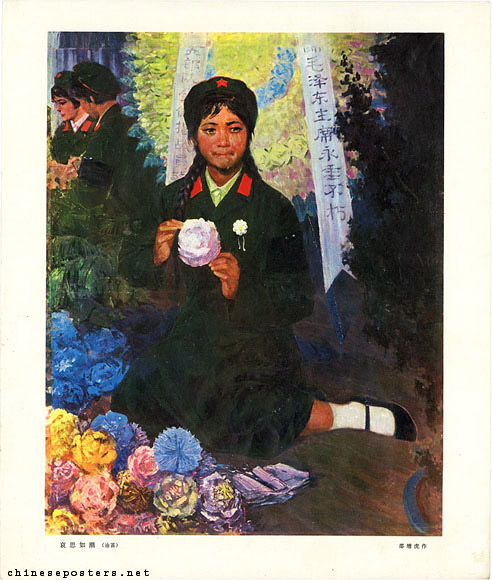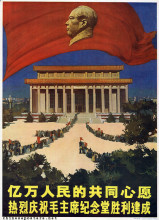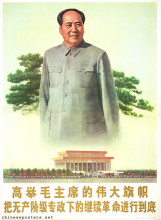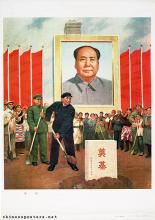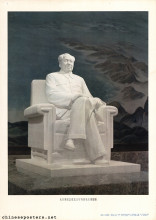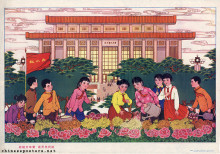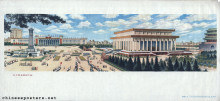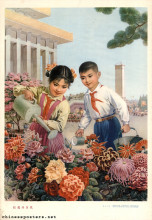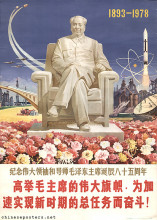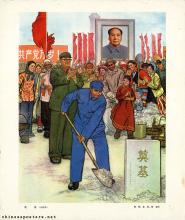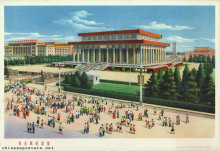When Mao Zedong died on 9 September 1976, the country was in shock. This was partly the result of the keenly felt loss of a semi-divine leader, but also caused by the enormous uncertainty about what the future held in stock for China and its people. The power struggle between Jiang Qing and the Gang of Four on the one hand, and Mao's designated successor Hua Guofeng on the other, which had been smoldering for some time, was about to be fought out in public. Some of this uncertainty is visible in the tenseness of the faces of the persons in the poster above.
However, on 6 October 1976, within a month after Mao's death, Hua had the Gang of Four arrested. This bold move was supported by various old Party cadres and Army men, including Ye Jianying, Li Xiannian, Xu Xiangqian and Nie Rongzhen.
Two days after the arrest of the Gang, the highest organs of the party and the state decided that a Memorial Hall would be built as a permanent tribute to the founder of the People's Republic. On 24 November 1976, the foundation stone for the gigantic building, located to the south of the Monument to the People's Heroes on Tiananmen Square (天安门广场), was put in place. Both Hua and Ye, the strong men of the immediate post-Mao era, were prominently present at the ceremony.
Laying the foundation, ca. 1978
The construction went on day and night, and the building was finished on 29 August 1977. On that same day, Mao's body, which had been embalmed and placed in a crystal sarcophagus, was moved to the Hall. On 9 September 1977, a ceremony was held to commemorate the anniversary of Mao's death and the completion of the Hall.
In December 1983, four memorial rooms were added to the Memorial Hall, which serve as reception rooms for important guests. Aside from the one to the left of the entrance hall, which is dedicated to Mao, the others are dedicated to his former colleagues of the First Generation of leaders, Zhou Enlai, Liu Shaoqi and Zhu De. For many artists and designers, contributing works to the Hall is seen as a mark of distinction, proof of them being in tune with the national mood. One of these contributing artists is Liu Yuyi, known for his huge canvasses that commemorate landmarks in recent Chinese (and world) history.
Pines and willows are ever green, flowers blossom red generation after generation, 1978
Although the Hall is open to the general public, it tends to be closed for maintenance purposes for extended periods of time. For precisely these reasons, the Hall was closed in the Summer of 2007 in preparation for the Olympic Games of 2008. It is unclear whether this maintenance was needed for the upkeep of the building, or for Mao's remains. Nonetheless, the Hall still draws large crowds of visitors, many of whom lay flowers at the foot of a marble statue of a sitting Mao, located in the northern entrance hall.
Dachang Cong, When Heroes Pass Away - The Invention of a Chinese Communist Pantheon (Lanham: University Press of America, 1997)
Guo Jian, Yongyi Song & Yuan Zhou, Historical Dictionary of the Chinese Cultural Revolution (Lanham: The Scarecrow Press, Inc., 2006)
Daniel Leese, "A Place Where Great Men Rest? The Chairman Mao Memorial Hall", in: Marc Andre Matten (ed.), Places of Memory in Modern China. History, Politics, and Identity (Leiden, Boston: Brill, 2012), 91-129
Kwok-sing Li (editor) & Mary Lok (translator), A Glossary of Political Terms of the People’s Republic of China (Hong Kong: The Chinese University Press, 1995)
Li Zhensheng, Red-Color News Soldier - A Chinese Photographer’s Odyssey through the Cultural Revolution (London: Phaidon Press, 2003)
Li Zhisui, The Private Life of Chairman Mao - The Memoirs of Mao’s Personal Physician (London: Random House, 1996)
Helmut Martin, Cult & Canon - The Origins and Development of State Maoism (Armonk, M.E. Sharpe Inc., 1982)
Rudolf G. Wagner, "Reading the Chairman Mao Memorial Hall in Peking: The Tribulations of the Implied Pilgrim", Susan Naquin & Chün-fang Yü (eds), Pilgrims and Sacred Sites in China (Berkeley: University of California Press, 1992)
Frederic Wakeman, Jr., "Mao’s Remains", James L. Watson & Evelyn S. Rawski (eds), Death Ritual in Late Imperial and Modern China (Berkeley: University of California Press, 1988)
Wu Hung, Remaking Beijing - Tiananmen Square and the Creation of a Political Space (Chicago: The University of Chicago Press, 2005)
Zhongguo jianzhu gongye chubanshe (eds.), Mao zhuxi jiniantang [Chairman Mao’s Memorial Hall] (Beijing: Zhongguo jianzhu gongye chubanshe, 1978) [in Chinese]
